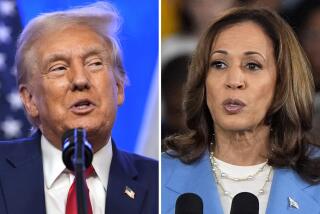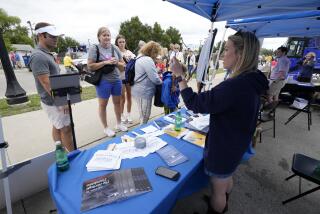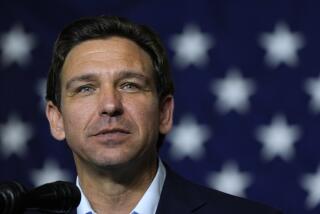Reelection Strategy Alters Bush Team
CRAWFORD, Texas — With careful pruning and a shifting of responsibilities, the Bush administration is transforming itself as the White House prepares for the 2004 presidential campaign.
Showing that it has learned from the failure of the president’s father to win reelection in 1992, the administration has weeded out members of the economic team who weren’t supportive enough of President Bush’s program.
But beyond the economic issue, so often cited as the reason for the failure of the elder Bush that it has become a political cliche, the administration learned the importance of organizing the staff -- both inside and outside the White House -- long before the reelection campaign actually begins.
Thus, a lineup that remained largely unchanged for two years has been reshaped by the departure of several of its top members -- some voluntarily, some under pressure.
The result is a White House staff focused on the top priority -- winning Bush’s reelection, should he seek a second term -- with some of the departing members positioned to work on the campaign from the outside, free of the constraints on political activity while on the government payroll.
According to Paul C. Light, an expert on government staffing at the Brookings Institution in Washington, this White House has taken a page from the Clinton administration’s playbook in which successful politics means governing while conducting a “permanent campaign.”
During its first two years, the Bush White House was well staffed with the veterans -- Karen Hughes, Mary Matalin, Joe Allbaugh and Karl Rove -- who helped elect a Texas governor with only one term in office when he began his quest for the presidency.
“Now,” said Light, “there’s a logical reshuffling outward toward the political apparatus, and a gut-check about who’s able to go the distance for 2004.”
But, he asked, is it necessarily the right lineup?
New Kind of Campaign
“The team that gets an obscure governor from Texas elected president is not necessarily the right team to get a sitting president reelected,” Light said. As “the personification of the government, not an outsider, Bush will need a more sophisticated strategy this time around,” he added.
To be sure, each of those leaving has individual reasons: Hughes, counselor to the president, headed back to Texas during the summer so her son could attend high school in his home state; Matalin, counselor to Vice President Dick Cheney, is leaving early next month to spend more time with her young daughters and return to the lucrative political punditry circuit.
Both will be available if Bush seeks their help. Hughes, for example, was frequently at the president’s side during his extensive travels during this fall’s congressional campaigns.
And Allbaugh, who served as chief of staff when Bush was governor and then managed the 2000 presidential campaign, is leaving as head of the Federal Emergency Management Agency in March, with the widespread anticipation that he will be deeply involved in any reelection drive.
Only Rove, Bush’s senior political counselor, will remain on the government payroll, positioned to oversee the work of the White House where policy and politics intersect.
But Treasury Secretary Paul H. O’Neill and Lawrence B. Lindsey, the president’s chief economic advisor, were given no choice about their departures. Looking for representatives of the administration’s economic policy who were more in sync with cutting taxes and stimulating economic growth, the president and his political aides decided that those two had to go.
A veteran Republican lobbyist who has served in two administrations and counseled two others put the departures of O’Neill and Lindsey earlier this month as one of the most important early campaign moves Bush could make. Assembling an economic team for 2004 means that Bush must have “the right image and the right spokespeople” in an arena that is consistently one of the voters’ greatest concerns, the lobbyist said.
Soon after the two were pressured to leave, Bush named railroad executive John W. Snow as his choice for Treasury secretary and Stephen Friedman, a Wall Street chieftain, as his economic advisor.
John Podesta, who served multiple roles in the Clinton White House and completed his tenure there as President Clinton’s last chief of staff, said the economic team’s transformation “was absolutely necessary.”
“The only real question was, would Bush’s vaunted loyalty to his staff overcome political sensitivity?” he asked. “They proved that political sensitivity took precedence.”
Clinton underwent a similar Cabinet shift in 1994, two years before his reelection campaign, though his first Treasury secretary, Lloyd Bentsen, resigned voluntarily. Robert E. Rubin, who had been head of Clinton’s national economic council and the public face of the administration’s successful effort to revive the economy in 1993, stepped in.
But Clinton, too, tuned up the West Wing: Thomas “Mack” McLarty was replaced as chief of staff by Leon E. Panetta, director of the Office of Management and Budget and a former Democratic congressman from California. Harold M. Ickes, a longtime Democratic activist, and Douglas B. Sosnick, a national party official, also took senior roles.
That meant two trusted political operatives were within feet of the Oval Office. And in Panetta, Clinton had the advice and political sensitivities of an expert on the budget and Congress.
“The political team was strengthened,” Podesta said. “There was a strong integration of the communications side with the policy development side, and Clinton was out on the road talking about his initiatives.”
Podesta looks with respect on the way Bush and his advisors are positioned, calling them “a muscle-bound political team.” The first President Bush brought in Gov. John H. Sununu of New Hampshire as his initial chief of staff.
When Sununu flamed out, he was replaced with a Chicago utility executive, Samuel Skinner. He too, failed.
With only months until the election in 1992, in came Secretary of State James A. Baker III, returning to the position he held at the start of the Reagan administration.
“It was too late,” Podesta said. Too much ground had been lost.
But the need to put an effective team in place within the White House and beyond at the very start of a reelection drive has not been lost on those who would follow.
Speaking privately about the importance of having the right staff conveying the right message -- and having both in place long before the voters are thinking about an election -- one senior Bush advisor reflected on the elder Bush’s campaign, through which a number of current White House aides had struggled.
“We learn from our mistakes,” the aide said.
*
(BEGIN TEXT OF INFOBOX)
Gone, but still players
The Bush White House has been reshaped by the departure of several top advisors. Among them:
Joe Allbaugh
Director, Federal Emergency Management Agency. Leaving in January. Allbaugh served as chief of staff while George W. Bush was Texas governor and managed the 2000 presidential campaign; he is expected to play an important role in any reelection bid.
Karen Hughes
Counselor to the president. Went back to Texas last summer so that her son could attend high school in his home state. She remains close to Bush and played an active role in the 2002 congressional campaign.
Mary Matalin
Counselor to the vice president. Leaving in January to spend more time with her two young daughters; she is expected to return to the political punditry circuit.
More to Read
Get the L.A. Times Politics newsletter
Deeply reported insights into legislation, politics and policy from Sacramento, Washington and beyond. In your inbox three times per week.
You may occasionally receive promotional content from the Los Angeles Times.










